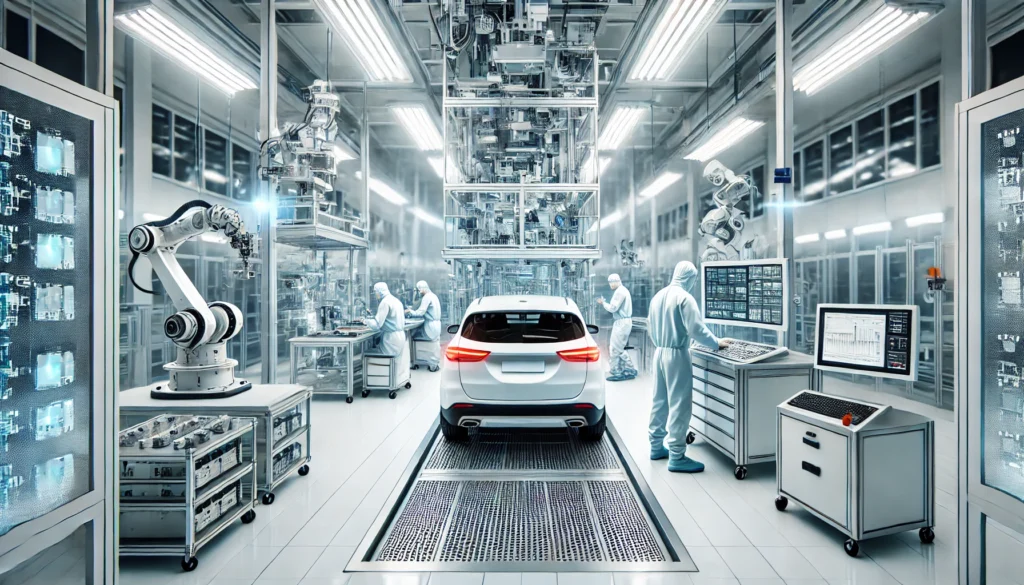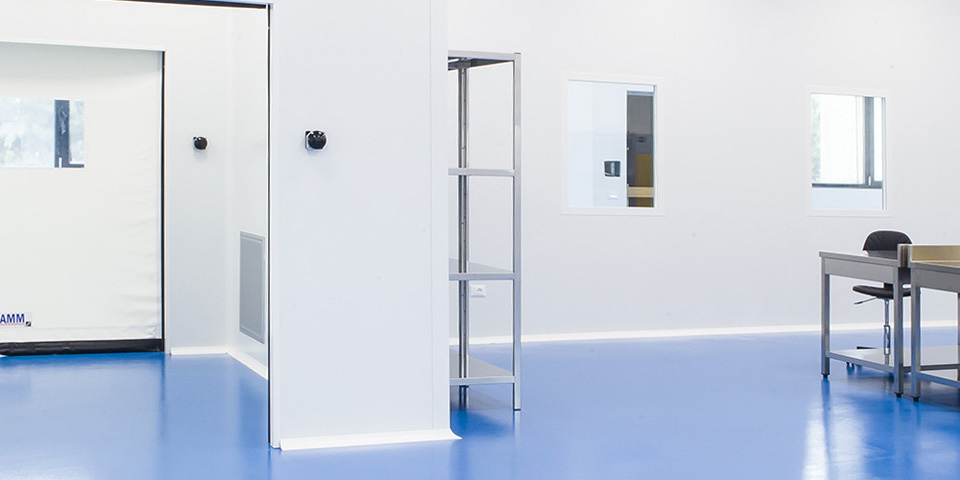The automotive industry demands high precision and reliability in every production phase, from electronic components to advanced coatings. Even the smallest contamination can compromise performance and durability. Cleanrooms for automotive provide controlled environments that ensure optimal manufacturing conditions, preventing defects and improving efficiency.
In this article, we will explore the critical role of cleanrooms in automotive production, the industry standards they must comply with, the latest technological advancements, and real-world examples of their successful implementation.
Applications of Cleanrooms in the Automotive Sector
Cleanrooms are increasingly essential in the automotive industry, particularly in the production of electronic systems, battery components, and high-performance coatings. As vehicles become more advanced, the need for precision manufacturing in controlled environments continues to grow. Cleanrooms for automotive help ensure consistent quality, reduce contamination-related defects, and enhance the longevity of critical automotive components.
Electronics and Sensor Manufacturing
Modern vehicles rely on sophisticated electronics, including sensors, microprocessors, and LiDAR systems for autonomous driving. These components require ultra-clean environments to prevent dust or microscopic particles from causing malfunctions. Contaminants can interfere with circuit pathways, degrade sensor accuracy, and compromise overall system performance.
Cleanroom-controlled environments ensure that semiconductor wafers, microchips, and circuit boards remain free from dust, which could otherwise cause electrical shorts or erratic behavior in vehicle control systems. For instance, advanced driver assistance systems (ADAS) require precise signal processing, which is only possible when their electronic components are manufactured in a contamination-free environment.
Battery and EV Component Production
With the rise of electric vehicles (EVs), lithium-ion battery production has become a crucial area where cleanrooms for automotive play a vital role. Particle contamination can lead to short circuits, affecting battery safety and longevity.
In EV battery manufacturing, airborne contaminants can alter the chemical composition of lithium-ion cells, reducing efficiency and increasing the risk of defects. ISO-certified cleanrooms prevent moisture, dust, and other impurities from compromising battery cell stability. Additionally, automated assembly lines in cleanrooms help maintain uniformity in electrode layering, crucial for battery performance and durability.
Furthermore, as solid-state batteries and hydrogen fuel cells gain traction, their production will demand even stricter environmental controls. Ensuring contamination-free materials is vital to optimizing the efficiency and safety of next-generation energy storage solutions.
Precision Coatings and Surface Treatments
Automotive manufacturers use cleanrooms for applying specialized coatings to critical parts, such as optical lenses, windshields, and high-performance engine components. Contaminant-free environments ensure perfect adhesion and durability of coatings.
For example, self-healing paints, anti-glare coatings, and protective films for autonomous vehicle cameras must be applied in particle-free environments to maintain performance over time. A single airborne contaminant can cause defects in coatings, leading to optical distortions, uneven wear, or peeling under harsh environmental conditions.
Moreover, cleanrooms are essential for the deposition of anti-corrosion and thermal insulation coatings on engine and exhaust components, extending their lifespan and improving vehicle efficiency.
Standards and Requirements for the Automotive Industry
Automotive cleanrooms must adhere to strict regulatory standards to guarantee product quality, reliability, and safety. Meeting these requirements ensures that components function optimally and maintain durability under real-world conditions. Compliance with industry-specific guidelines is crucial for reducing contamination risks and enhancing production efficiency.
ISO 14644 Classification
The ISO 14644 standard defines cleanroom classifications based on the number of particles per cubic meter of air. Automotive cleanrooms typically range between ISO Class 5 and ISO Class 8, depending on the sensitivity of the manufacturing process.
For example:
- ISO Class 5: Used for high-precision microelectronics and sensor production, ensuring minimal airborne contamination.
- ISO Class 7-8: Suitable for battery assembly, interior components, and general electronic modules, where contamination control is essential but less stringent.
Maintaining these standards prevents costly recalls due to defective components, which could compromise vehicle safety and performance.
Environmental Control Parameters
To maintain product integrity, cleanrooms must strictly regulate:
- Temperature and Humidity: Ensuring stable conditions prevents material expansion and degradation, particularly for adhesives, coatings, and battery cells.
- Air Filtration: HEPA (High-Efficiency Particulate Air) and ULPA (Ultra-Low Penetration Air) filters remove airborne contaminants, safeguarding sensitive automotive components.
- Electrostatic Discharge (ESD) Control: Essential for protecting electronic parts from damage during assembly, as uncontrolled static electricity can lead to circuit failure.
Compliance with Automotive Quality Standards
Cleanrooms used in automotive manufacturing must align with industry-specific certifications to ensure consistent quality and safety:
- IATF 16949: The global standard for automotive quality management systems, focusing on defect prevention and reducing variation in production.
- ISO 9001: Ensures standardized processes for high-quality production, applicable across all automotive manufacturing sectors.
These certifications help manufacturers maintain strict quality control, minimizing the risk of defects that could impact vehicle reliability and safety.
Emerging Technologies in Automotive Cleanrooms
Innovations in cleanroom design and operation are revolutionizing automotive manufacturing, enhancing efficiency, precision, and sustainability. With the rise of automation and digitalization, cutting-edge technologies are being seamlessly integrated into cleanroom environments to improve production quality and reliability.
Automated Manufacturing and Robotics
The integration of robotics in cleanrooms for automotive minimizes human contamination, allowing precise assembly of delicate automotive components. Automated guided vehicles (AGVs) further optimize logistics within clean environments by transporting materials without introducing external contaminants.
Robotic arms, equipped with advanced sensors and AI-driven precision tools, ensure that microchips, sensors, and coatings are applied consistently, reducing the risk of human error.
IoT and Smart Monitoring
Real-time monitoring systems equipped with IoT sensors detect fluctuations in temperature, humidity, and airborne contaminants. These systems ensure a proactive approach to maintaining optimal cleanroom conditions.
With AI-driven analytics, manufacturers can predict maintenance needs and avoid costly downtime. Smart monitoring also provides automated alerts in case of deviations, preventing potential defects before they reach the final production stage.
Sustainable Cleanroom Practices
New energy-efficient filtration systems and air recirculation technologies reduce power consumption, making cleanroom operations more sustainable. Additionally, the use of biodegradable materials for cleanroom garments supports environmental responsibility.
Green cleanroom innovations include:
- Low-energy HEPA filtration systems that maintain high air purity while reducing energy consumption.
- Closed-loop air recirculation to minimize the waste of filtered air.
- Eco-friendly cleaning agents to reduce the environmental impact of maintenance processes.
By adopting these sustainable practices, automotive manufacturers can align with global environmental goals while maintaining top-tier quality standards.
Case Study: Successful Implementations in the Automotive Sector
The impact of cleanrooms on the automotive industry is evident through real-world examples. Here are a few successful implementations that highlight the benefits of controlled environments in automotive manufacturing.
Enhancing Electric Vehicle Battery Production
A leading EV manufacturer implemented ISO Class 6 cleanrooms for lithium-ion battery assembly, reducing contamination-related defects by 40%. This resulted in increased battery lifespan and safety.
With higher energy density and reduced failure rates, the company’s battery packs met stringent safety regulations, ensuring reliability in extreme conditions. As a result, their vehicles achieved better range and durability, strengthening their position in the competitive EV market.
Advanced Coating Processes for Automotive Glass
A global automotive glass manufacturer adopted cleanroom environments for high-precision coating applications. The controlled atmosphere led to a 25% improvement in optical clarity and scratch resistance.
Their cleanroom-enabled coating technology reduced light distortions in heads-up displays (HUDs) and rearview mirrors, enhancing driver visibility and safety.
Precision Assembly of Autonomous Vehicle Sensors
A Tier-1 automotive supplier introduced cleanroom assembly lines for LiDAR and radar sensors used in autonomous vehicles. This reduced failure rates by 30%, ensuring better performance in real-world conditions.
By maintaining contaminant-free conditions during sensor production, the supplier improved the accuracy of object detection, lane departure warnings, and collision avoidance systems.
Conclusion
Cleanrooms have become a vital part of the automotive industry, ensuring the highest levels of quality, safety, and performance in vehicle components. From sensor manufacturing and battery assembly to precision coatings, these controlled environments play a crucial role in advancing automotive technology.
With emerging innovations such as robotics, IoT monitoring, and sustainable cleanroom practices, manufacturers can achieve higher efficiency while minimizing environmental impact. By investing in cleanroom technology, automotive companies can maintain compliance with industry standards, enhance product reliability, and drive innovation in an increasingly competitive market.
For manufacturers looking to optimize their production processes, integrating cleanroom for automotive solutions is a strategic move that guarantees long-term success.


